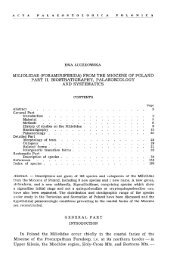Full text (652.0 kB) - Acta Palaeontologica Polonica
Full text (652.0 kB) - Acta Palaeontologica Polonica
Full text (652.0 kB) - Acta Palaeontologica Polonica
You also want an ePaper? Increase the reach of your titles
YUMPU automatically turns print PDFs into web optimized ePapers that Google loves.
<strong>Acta</strong><br />
Vol. 28, No. 3-4<br />
<strong>Palaeontologica</strong><br />
pp. 385-391; pls. 9-12<br />
.<br />
ANDRZEJ PISERA<br />
'COMATULID AND ROVEACRINID CRINOIDS FROM<br />
THE CRETACEOUS OF CENTRAL POLAND<br />
<strong>Polonica</strong><br />
Warszawa, 1983<br />
P1SERA, A. : Comatulid and roveacrinid crinoids from the Cretaceous of Central<br />
Poland. <strong>Acta</strong> Palaeont. Polonlca, 28; 3-4, 385-391, 1983 (issued 1984).<br />
Two crinoid species: Glenotremttes sp , and Styracocrinus peracutus (Peck) from<br />
Albian-Cenomanian deposits In Central Poland are described. The Isolated arms<br />
elements found In the same sample as the cups were the basis for the reconstruction<br />
of the arms structure in both s pecies.<br />
Ke y w 0 r d s: Crinoidea, Cretaceous; Poland.<br />
Andrzej Pis era, Zaklad Paleoblologll , Polska Akademla N auk, AI. Zwlrkl I WIgu<br />
r y 93, 02-089 Warszawa, Poland. Received : November 1981.<br />
GENERAL REMARKS<br />
Cretaceous crinoids from Poland are little known and rarely described.<br />
Up t q now only Marsupites from the Upper Cretaceous of Krak6w region<br />
was listed (Smolenski 1906, Panow 1934), Glenotremites paradoxus (Goldfuss)<br />
fr om the Upper Cretaceous of Opole region was described by Wegener<br />
(1913), (in Wegener's paper the species appeared under the name<br />
Gl enotremites tietensi) and recently, Merta (1972) described the cup of the<br />
Bourgeticrinus utriculatus (Valette) from the Senonian of Krak6w Upland;<br />
stem fragments of the Bourgeticrinus from the Upper Cretaceous<br />
of Pulawy region are also mentioned by Kongiel (1937).<br />
Comatulid crinoids are fairly common ' fossils in the Cretaceous of<br />
Europe and North America (see for example Gislen 1'924, 1925; Rasmussen<br />
1961; Zitt 1980). Similarly, roveacrinid crinoids are common in<br />
the Cretaceous of Germany (Jaekel 1918, Sieverts 1932, 1933), England,<br />
France, (Douglas 1908, Peck 1955, Rasmussen 1961, 1'971) and North<br />
America (Peck 1943, Scott et al. 1977). Roveacrinids (Orthogoncrinus and<br />
Roveacrinus) from the Cretaceous of Bohemia were described by Nekvasilova<br />
and Prokop (1963). Cretaceous roveacrinids were not known<br />
from Poland up to now.<br />
Crinoids described in this paper come from gray marls found in the<br />
borehole W-20 in the vicinity of Barcin-Piechcin (Kujawy region), at
390 A N D RZEJ PISERA<br />
W oparciu 0 izo low ane brachialia znalezione w tej sa m ej probie co kielichy,<br />
prze pr ow adzono r ek onstrukcje budowy ramion u obydw u Hliowcow, U liliowca<br />
Styracocrinus peracutus (P eck ) stw ierdzon o wystepowanie dwu typow el ern entow,<br />
ktore odpowiadaja IBrl i ktore sa wo bec siebie jak lu strzane odbicia. Zinterpre<br />
towano ten fakt jako przejaw zrniennosci wewnatrzga tunkowe]<br />
EXPLANATION OF PLATES 9-12<br />
Plate 9<br />
Glenotremites sp. Scale bar 0.5 mm<br />
1. Aboral view of centrodorsal showing small dorsal star and densely packed<br />
cirral sockets without crenulation. ZPAL Call/I.<br />
2. Oral view of centrodorsal sh ow ing basal impressions and narrow dorsal cavity.<br />
ZPAL CaIlI/2.<br />
3-4, 6, 8. Brachials with both articulations of the muscular type: some of them<br />
bear small spiny outgrowths on the dorsal side. ZPAL CaIII/1l7, ZPAL CallI/6,<br />
ZPAL CallI/5, ZPAL CallI/1l8.<br />
5. Brachial showing one facet with weakly crenulated rim. ZPAL CaIII/4.<br />
· 7. Distal ' view of first primibrachial showing sy nar thial ar ticu la ti on. ZPAL<br />
CaIlI/3.<br />
1.<br />
2.<br />
3.<br />
- 4, 6.<br />
- 5.<br />
Plate 10<br />
Glenotr em ites sp. Scale bar 0.2 mm<br />
Distal cirra l in la teral view. ZPAL CallI/1l9.<br />
Ar ticulation su rface of dist a l cirral. ZPAL CaIII/116.<br />
P roxim al v iew of second primibrachial showing sy narthial articulation w ith<br />
the first primib rach ial and sma ll spiny ou tg ro wths on the d orsal side.<br />
Bra chials with syzygial a r ticu la r Iace ts : ,secon d facet is of muscular type.<br />
ZPAL CaIlI/l08. ZPAL CaIIII1l3. .<br />
Secundibrachial (probably second) with synarthial articulation, second facet<br />
of muscular type with pinnular socket. ZPAL CallI/lll.<br />
Plate 11<br />
Sturacocrinus peracutus (Peck). Scale bar 0.2 mm<br />
1. Lateral vi ew of ca lyx show ing articular fac et of a rms, str ong ly sloping outwards,<br />
a boral part of cup de stroyed. ZPAL CallI/8.<br />
· 2. Dorsal view of calyx show ing destroyed abo ral part of ca lyx and well developed<br />
supports of a r ms articulation surface. ZPAL CaIlII7.<br />
..3. Calyx , a rm articulation facet showing large neural canal and a long and narrow<br />
ligamentary field. ZPAL Ca/IIl/8.<br />
· 4. Proximal facet of IBrl corresponding to the facet of radial plate (see fig. 3).<br />
ZPAL CaIlI/1l5.
ACTA PALAEONT. POL., VOL. 28/3-4 A . PISERA. PL. 9
A CTA PALAEONT. POL., VOL. 28/3-4<br />
A . PISERA, PL. 11
ACTA PALAEONT. POL., VOL. 28/3-4 A . PISERA, PL. 12

















